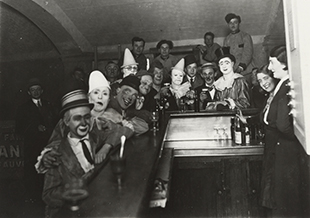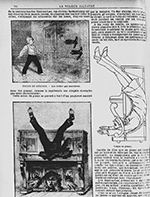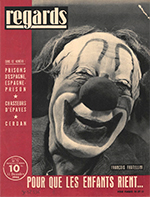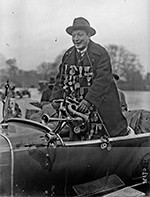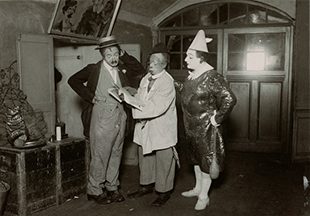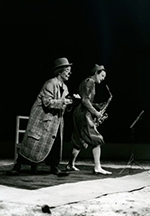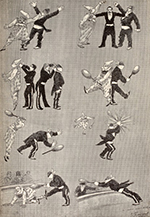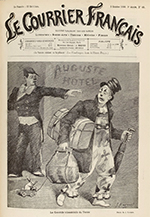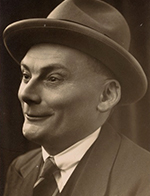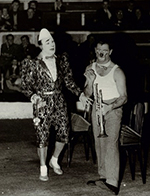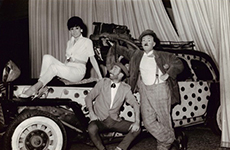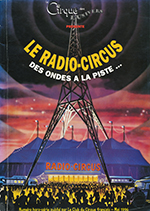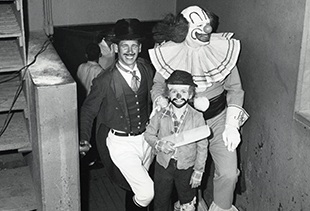Clowns in the French press
by Marie-Ève Therenty
The history of clowns is inseparably linked to the press in France. In the absence of recording, press articles on the circus have long formed the collective memory of clown acts and the history of clowns is the work of journalists working on the circus who have compiled and re-written their archives. Tristan Rémy was a specialist in circus and music hall in L'Humanité between 1936 and 1939 and his book Les Clowns largely includes his press articles.
Clowns and writer-journalists
As early as the first half of the 19th century, some theatre serialists who were also literary men opened up to the circus and reported on the clown's entrees. The visibility given to some clowns who have become famous figures in Parisian life is due to this early media coverage. Théophile Gautier wrote in La Presse on the 21st of August 1837 that Auriol was "the most spiritual and charming clown imaginable". Jean de Tinan and Jean Lorrain were fervent fans of Foottit. The growing fame of clowns in the years between the two world wars accompanied the specialisation of a few chroniclers who became circus specialists, such as Pierre Varenne, Gustave Fréjaville, André Legrand-Chabrier, and later on Serge [Maurice Feaudière] and Jacques Richard. It is through the press and its writers that the figure of the clown has long been intellectualised and celebrated and it is impossible to conceive the history of clowns without thinking about this connection. Perhaps this period ends symbolically when the columnist Jacques Richard gives the newspaper Le Figaro, after thirty years of reviews, his last article, the obituary of the man who was perhaps the last great media clown, Achille Zavatta, on the 17th of November 1993.
A history of clowns
Consulting the press archives is therefore an inexhaustible resource that makes it possible both to document the great traditions of clown history: the reign of the clown acrobat or squire like Auriol, the vogue of English clowns, the rise of the Auguste who imposed duets, then the clown trios, but also to see them recorded through writers journalists, circus historians ahead of their time. Théophile Gautier is the first to justify the attachment of the acrobat from the Cirque Olympique des Champs-Élysées to the still floating category of clowns. Theodore de Banville accompanied the English clown trend in the mid-19th century with media coverage before composing a preface to introduce the apocryphal memories of the Hanlon-Lees written by Richard Lesclide in 1879. Baudelaire based his theory of the essence of laughter, a text that first appeared in Le Portefeuille on the 8th of July 1855, on the appearance of the English clown, worrying under his dark tailcoat.
The journal, in the absence of other forms of recording, also makes it possible to create an archive of detailed acts and programmes. The circus chroniclers describe the costumes, narrate the intrigues when they do not reproduce the texts of the "entrees". Le voleur illustré, on the 21st of December 1893, gives the diagram of the Hanlon-Lees' rigged piano. Regards, on the 13th of December 1946, reveals the different stages of the make-up of the Auguste of the Fratellini trio. The articles are not without unfortunate mistakes: the journalist from Regards thinks he is dealing with François although it is Albert Fratellini.
The celebrity clown
From the end of the 19th century, in France, the great clowns became stars, just like the actors. Their private lives are in the media. Le Journal, on the 23rd of December 1934, featured the wedding of the clown Carletto with Violette Fratellini. In Le Matin on the 28th of February 1941, we witness the meals of the family of the clown Polo Rivels and his eight children. The press is full of clown gossip. Thus in 1894, a crazy rumour was spreading: the clown Foottit broke his commitment to the Nouveau Cirque to follow a dancer in Russia with whom he was in love, leaving his legitimate wife and four children in Paris. When clowns die, their obituaries fill the newspaper pages and make the headlines for the biggest celebrities. This star status of the great clowns continued after the Second World War with Rhum, Achille Zavatta, Rolf Knie junior, Annie Fratellini, even if it gradually weakened. Today, the media coverage and stardom of clowns have decreased. An article in Le Monde, "Le clown se meurt" (" The clown is dying"), published on the 28th of August 1980, blames cinema and television for the clown's diminished visibility.
The clown's social body
The press is also a revealing indicator of the changing role of the clown in society. Today, the press highlights, perhaps under the influence of the cinema, the news stories perpetrated by sinister clowns attacking passers-by. It is coulrophobia recently revived by the film It inspired by Stephen King. But for a long time, clowns in the news were considered more like guardian angels. According to Le Gaulois of the 8th of November 1881, Medrano known as Boom Boom, "the clown loved by the crowd" extinguished a fire that broke out during a performance. Again, on the 15th of July 1953, Le Monde informed us that the clown Zavatta saved a tamer from his furious lions.
Above all, the press informs about the reality of the clown's social body and the difficulty of the job under the mask. A survey of "men who laugh, even when they have tears in their eyes and sorrow in their hearts" shows the misery of the Augustes, these anonymous and invisible clowns (Le Petit Journal, 16th of November 1928, page 1). Interviews with famous clowns, when they are not exclusively for promotional purposes, are revelations about the discomfort of the clown, even when they are very popular. "For twenty years I have made a thousand of my fellow citizens laugh every night; for twenty years I haven't laughed once myself," said Foottit in Les Annales politiques et littéraires on the 18th of September 1921.
Journalistic clowneries
Clowns and journalists, two professions that play with signs, have not only lived happily with each other for a long time, but they have also shared an equally imaginative spirit of complicity. During the Belle Époque and again in the interwar period, clowns were present in all the general press, not only in advertisements and show announcements but also in cartoons and press cartoons, news items, surveys and interviews. Some serial novels such as Albert Boissière's Le Clown rouge, published in Le Petit journal Illustré from the 6th of February 1910, feature the comedy artists who are often on the front page of the mass media. Satirical journalists have sometimes even titled their drawings or sketches "clowneries" or "clown entrees". In return, to compose his scenes, the clown, anticipating the practices of comedians, feeds on the same news as the newspaper. In an interview with Le Temps on the 18th of November 1903, the clown Foottit stated that he found these stage topics in the news items of the English and French newspapers.

![]() read the short story Boum-Boum, by Jules Claretie, published in Le Supplément illustré du Petit Journal on the Sunday 3rd of November 1907 (beginning on the right at the bottom of the page)
read the short story Boum-Boum, by Jules Claretie, published in Le Supplément illustré du Petit Journal on the Sunday 3rd of November 1907 (beginning on the right at the bottom of the page)
Clowns, from television to new media
by Alix de Morant
Television was wrongly accused of having, in the immediate post-war period, replaced the travelling circuses that criss-crossed the county roads and planted their big tops in local villages in an effort to disrupt their mundane existence. It is true that the "entertainment society", as described by Guy Debord in 1967, means the end of an era and that the multiplication of TV sets that bring new attractions, royal coronations, sporting achievements and entertainment to homes has had a considerable impact on the economy of these small businesses, already weakened by two world wars. When the "news", which, in Vichy France, caught the last rehearsals of the three Fratellini (Paul died in 1940), disappeared from the cinemas, the RDF Télévision Française, then the RTF and the ORTF took over to perpetuate the legend. Annie Fratellini, Paul's granddaughter, will immortalise the family album for the television screen, her very own family album, which will be extended to include the clowns, from Grimaldi to Charlie Rivel. She can be found in the series "Il était une fois le cirque" ("Once upon a time the circus") produced for Récré A2 in 1985, commenting on historical documents and archives, including these shots taken during a 1931 music hall performance in Berlin where Grock (Charles Adrien Wettach, 1880-1959) tries to reconcile the good graces of his partner with the eloquent accents of a concertina.
Annie Fratellini, again, appears alongside the white Francesco Caroli, but also the Americans David Shiner, a contemporary Auguste, and Michael Christensen, a tramp, in Les Chiffonniers du rire, part of a trilogy on the lives of circus artists in the world or Les Enfants du voyage, documentary made for television, in 1992 by Laurent Chevallier.
Telegenic clowns
As circus ambassadors, the television cameras will soon leave the ring to go backstage and invite themselves into the dressing rooms, fascinated by the make-up ritual that transforms the ordinary man into a clown deity. They even go so far as to step into his private life to surprise him at home in his bathrobe and slippers. From the troupe leader who knocks down the billposters of a competing circus and drives the convoy on his sputtering motorcycle (Un Cirque passe, a 1950 documentary by Jacques Letellier and Jean-François Mehu) to "La Piste aux Étoiles", Achille Zavatta, has become a real star, commenting with the greatest seriousness on Bergson's Le Rire. "When I see someone on television once, I never forget them." he told Jacqueline Huet, an accomplice for one night in the Mauvais payeur ("Bad payer") sketch. His facial features, punctuated by his two commas, will become more known to viewers than the blonde face of the famous presenter. Produced first by La première chaîne ("The First Channel") then by Antenne 2 and successively shot at Le Moulin de la Galette, Le Cirque d'Hiver, at Pinder or at Jean Richard, Gilles Margaritis' show (1912-1965) made the reputation of his clowns. Jacques Massonnat (1926-2012), alias Jacques Francini, formed with Michel Francini (1921-2014) the first duo of "La Piste aux Étoiles", then joined by the white clown Alex, whose real name was Alex Bugny de Brailly (1897-1983). Under the spotlight, the Francesco, Rossi and Rastelli followed one another, but the prize for telegeny went to the junior Bario trio, which brought together an elegant and excellent young woman musician, Henny Sosman, with two Augustes, Freddy, her husband and Nello, her brother-in-law. Creators of many sketches, including the famous Davy Crockett, the Bario are the darling of the podiums, of 1, 2, 3... en piste presented by Marcel Fort and of Messieurs les clowns on Télé Dimanche with Guy Lux.
The media circus
While several generations of children still have the theme song of Kiri the Clown ringing in their ears, the next generations are beginning to grind their teeth with Krusty, the Simpsons' sinisterly disillusioned character, inspired by another TV clown, the famous Bozo, who also serves as a model for Ronald Mac Donald's frozen grin. The joke turns into a nightmare with the invasion of the gory series that feature strange, bloodthirsty and insane clowns, triggering the wrath of representatives of the World Clown Association, offended to see the idealised image of a jovial, good-natured clown tarnished. Among the grimacing buffoons, one of them is very popular with talk shows that foster an outrageous atmosphere of scandal. The presence of Jango Edwards (1950) instantly increased the audience. Let us remember the live ransacking of the Nulle part ailleurs studio set (Canal +, 1990s). We forget that the artist, originally from Detroit and the inspiration for the Amsterdam Festival of Fools (1975-1984), is a pure product of the beat generation, a former activist involved in demonstrations against the Vietnam War before being the fool of the public and private channels. His methods, parody and derision, have been used since the Gulf War by altermondialists, who, in clashes, destabilise the police forces with their antics and flood social networks in order to encourage Internet users to make up their minds to join the clown armada (Artnez des clowns).
From cathode ray tube to fibre optics
Produced by France 3 Région Corse, the adventures of Frico, a series of fifty episodes written and performed by the actor and director Jean Michel Ropers, are based on the recurring figure of the humanist and poet mime, fundamentally ill-adapted in a society that values instant immediacy and performance. Their format is similar to the video clip used by Marcel Amont to accomplish his metamorphosis into an Auguste over the course of his song Moi le clown (1963). In another vein, he finds himself in the clowning tutorials initiated by urban dancer Tommy the Clown (Thomas Johnson) to defuse social violence, a phenomenon that, propagated via social networks from the Los Angeles ghettos, gives rise to krump.
After an accident that ended an acrobatic career, Arnaud Clavet, a graduate of the 7th class of the CNAC and a founding member of the company Anomalie& (1995) began shooting in his kitchen and with the contents of his cupboards the hilarious short films that feed the nonochannel. Nono, his alter ego, filmed in a close-up shot, like the speakerines of yesteryear, lives in the digital age and plays on his ukulele as well as on the touch screens. He has put his red nose away but remains an ecologist, adept of decreasing growth and "smoking", an Alexandre le Bienheureux (Blissful Alexandre) of the twenty-first century. Fakir, magician, pickle tamer at his time, he is an epicurean whose digestion torments him with hallucinations.
A virtual audience?
If clowns often work in pairs or trios, their partner, as François Fratellini reminded us, is the audience. "We are not three but four: Paul, Albert, me and the audience! "Spectators, viewers and Internet users are no further from the circus, whether they come to sit in the stands in front of a sawdust circle or enjoy it in pieces through their screens. Television broadcasts live shows, including the Gala de l'Union, which, since 1923, has offered theatre, music hall and film stars the opportunity to experience the very essence of the entertainment profession and to accompany the evolution of contemporary circus through Le Festival Mondial du Cirque de Demain. It has an aura of great artists and encourages new talents often featured on Le Plus grand cabaret du monde. It provides an opportunity, through its coverage, to reveal the creative processes and through the archive, now accessible online, to perpetuate and renew the great tradition of clown entrées. As for the media universe, isn't it, in a way, a fairground show with its entertainers, whether they be Devos or Desproges who juggle words or those who use few words like the Deschiens?





